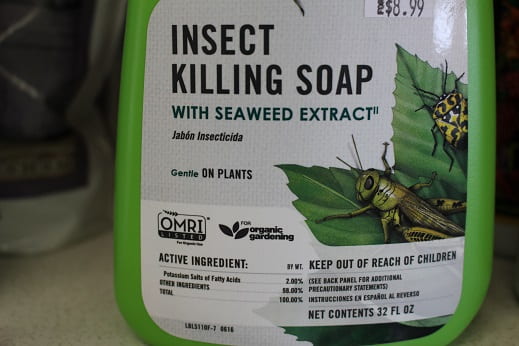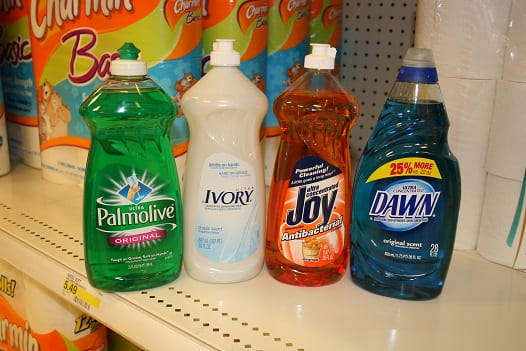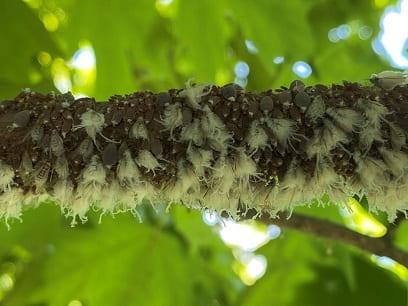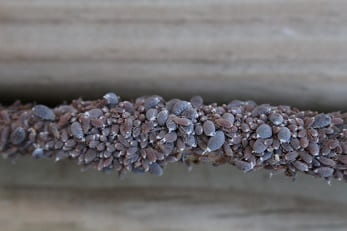–by Dr. Raymond Cloyd
Insecticidal soaps are classified as biorational or “reduced risk” insecticides and are used in certain situations because they leave minimal residues, are less toxic to humans, and are short-lived in the environment because they degrade rapidly. A soap is a substance derived from the activity of an alkali such as sodium (hard soap) or potassium (soft soap) hydroxide on a fat. In general, fats are a blend of particular fatty acid chain lengths. Soap is a general term for the salts of fatty acids. Soaps may be combined with fish, whale, vegetable, coconut, corn, linseed, or soybean oil. For example, “Green Soap” is a potassium/coconut oil soap that was used widely as a liquid hand soap in public restrooms. It is now available as a hand soap or shampoo, and has been shown to be effective, as an unlabeled insecticide, in controlling soft-bodied insects.

Fig 1. Insecticidal Soap Product (Author–Raymond Cloyd, KSU)
Commercially available insecticidal soaps containing the active ingredient, potassium salts of fatty acids (Figure 1), are used against a variety of soft-bodied insect and mite pests including aphids, scales, mealybugs, thrips, whiteflies, and the twospotted spider mite, Tetranychus urticae. The young life stages (nymphs, larvae, or crawlers) are most susceptible to soap applications. Soaps have minimal activity on beetles and other hard-bodied insects although this is not always the case as certain soaps have been shown to kill hard-bodied insects such as cockroaches. Soaps are effective only when insects or mites mite activity as soap residues degrade rapidly; especially under sunlight (ultraviolet light).
The mode of action of soaps is still not well-documented; however, soaps may kill insect and mite pests in one of three ways. First, soaps may work when fatty acids penetrate through the insect’s outer covering (cuticle) and dissolve or disrupt cell membranes. This interferes with cell integrity causing cells to leak and collapse, destroys respiratory functions, and results in dehydration and death of an insect or mite. Second, soaps may act as insect growth regulators interfering with cellular metabolism and the production of growth hormones during metamorphosis. Third, soaps may block the spiracles (breathing pores), which disrupts normal respiration.
There are varieties of fatty acids; however, only certain fatty acids have insecticidal properties, which is associated with the length of the carbon-based fatty acid chains. Most soaps with insect and mite activity are composed of long chain fatty acids (10 or 18-carbon chains) whereas shorter chain fatty acids (9-carbon chains or less) have herbicidal properties, so using materials that have short chain fatty acids can kill plants. For example, oleic acid, an 18-chain carbon fatty acid, that is present in olive oil and other vegetable oils, is very effective as an insecticidal soap.
Insecticidal soaps may directly and indirectly harm beneficial insects and mites. For example, one study showed that insecticidal soap was directly harmful to the predatory mite, Phytoseiulus persimilis. Another study reported that applying an insecticidal soap at a 4% application rate resulted in 80 to 99% mortality of the predatory mite, Neoseiulus (=Amblyseius) cucumeris.

Fig 2. Dishwashing Liquids (Author–Raymond Cloyd, KSU)
There is a general misconception that any soap or laundry detergent can be used as an insecticide. This is not true. As already mentioned, only a few select soaps have insecticidal properties, but many common household soaps, laundry detergents, and dishwashing liquids including PalmoliveÒ, DawnÒ, IvoryÒ, and JoyÒ (Figure 2), which are unlabeled insecticides, may have some activity on soft-bodied insects when applied at a 1% or 2% aqueous solution. However, reliability is less predictable than soaps (potassium salts of fatty acids) that are formulated and registered as insecticides.
Examples of various dishwashing liquids on insect and mite pests are provided below:
1) PalmoliveÒ, DawnÒ, JoyÒ, IvoryÒ, and DoveÒ reduced the numbers of sweet potato whitefly,
Bemisia tabaci; green peach aphid, Myzus persicae; cabbage aphid, Brevicoryne
brassicae; and twospotted spider mite on a variety of vegetable crops.
2) Dawn UltraÒ dishwashing liquid was effective on the German cockroach, Blattella
germanica, causing 100% mortality.
3) IvoryÒ liquid dishwashing soap applied at 0.4 to 3.0% concentrations controlled spider mites,
aphids and psyllids.
4) IvoryÒ liquid dishwashing soap at 1 and 2% concentrations was effective in controlling
aphids, spider mites, psyllids, and thrips.
5) New DayÒ dishwashing detergent applied at 2.0 ml/L provided 95% mortality of silverleaf
whitefly, Bemisia argentifolii (=Bemisia tabaci biotype B), nymphs.
6) IvoryÒ liquid dishwashing soap and TideÒ detergent were effective in reducing populations of
aphids; citrus red mite, Phyllocoptruta oleivora; psyllids; and greenhouse thrips, Heliothrips
haemorrhoidalis, on landscape plants.
However, dishwashing liquids and laundry detergents are primarily designed to dissolve grease from dishes and clean clothes; not kill insects and mites. The type of fatty acid, length of the carbon-based fatty acid chain, and concentration in many laundry and dish soaps is not known. In addition, the insecticidal effectiveness of these products may be compromised by the presence of coloring agents or perfumes, which often times leads to inconsistent results. Certain laundry and dish soaps will precipitate or solidify in “hard” water, thus reducing their effectiveness. Furthermore, these materials may cause plant injury by dissolving the waxy cuticle on the leaf surface. Registered, commercially available insecticidal soaps are less likely to dissolve plant waxes than household cleaning products. In addition, plants with pubescent (hairy) leaves may be more susceptible to injury from dishwashing liquids and detergents.
Dishwashing liquids and laundry detergents, like insecticidal soaps, lack any residual activity and thus more frequent applications are required. However, too many applications will harm certain plant types. Moreover, detergents are chemically different from soaps and may cause phytotoxicity (plant injury). In fact, many hand soaps are not necessarily pure fatty acids. Most importantly, these solutions are not registered insecticides. Soap companies do not intend for their products to be used as insecticides as they have not gone through the Environmental Protection Agency (EPA) registration process.
Although some dishwashing liquids and laundry soaps are active on insect and mite pests, they should not be used because they are not registered insecticides. Even more important is that a pest control company will generally stand behind a product when there is a problem. However, if a dish or laundry soap is used and plants are injured—there is no recourse.









